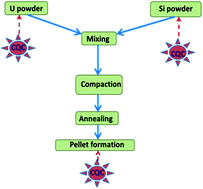Development of an AES based analytical method for the determination of trace metallic impurities in uranium silicide dispersion fuel: from precursors to end products†
Abstract
An analytical method was developed based on the D.C. arc carrier distillation atomic emission spectrometric (D.C. Arc AES) technique for determination of trace metallic impurities (Al, Ca, Co, Cr, Cu, Fe, Mg, Mn, Mo, Na, Ni, Si, Sn, Ti, V and Zn) in uranium silicide samples. Chemical quality control was also carried out for the precursor materials in order to track the source of impurities in the final fuel materials. The method was validated using synthetic samples. To minimize the spectral interference, a suitable carrier (5% AgCl) was used to sweep away the trace constituents into the arc preferentially, leaving the major matrix as a refractory material. The use of a charge coupled device (CCD) detector was found to improve the overall analytical performance in terms of detection limits, precision, linear dynamic range and most importantly providing an opportunity to choose additional analytical lines, which is highly desirable, especially for trace level determination of analytes in an emission-rich matrix. The energy dispersive X-ray fluorescence (EDXRF) spectroscopic technique was employed each time for comparative evaluation of the precursors and the product.



 Please wait while we load your content...
Please wait while we load your content...